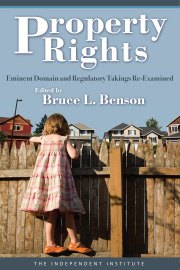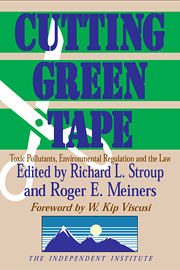Most Americans seldom think about the Third Amendment. Relegated by most scholars and courts to footnotes and history books, the Third Amendment states, “No Soldier shall, in time of peace be quartered in any house, without the consent of the Owner, nor in time of war, but in a manner to be prescribed by law.” The federal government pays for quartering soldiers, and military bases are highly sought after political prizes, not the subject of popular discontent.
That wasn’t always the case, however. All during the colonial period Americans resisted British military authorities’ attempts to quarter soldiers on individuals’ property without compensation. That experience led to the Third Amendment’s inclusion in the Bill of Rights and in numerous state constitutions as well.
The federal government may no longer involuntarily quarter troops but it is still attempting to use private property to “quarter” living creatures. Under the Endangered Species Act (ESA), the federal government routinely forces private property owners to bear the cost of supporting those species officially listed as “endangered.” Those costs can be substantial—many species require large areas of undisturbed land around their nests and dens, for example, effectively ending the ability to develop or otherwise use land.
What’s the connection with the Third Amendment? We started wondering what would happen if we took one of the left’s favorite constitutional legal theories seriously and applied former Supreme Court Justice William Brennan’s “living constitution” theory to the Third Amendment. Could ESA pass constitutional muster?
Unlike some of the other parts of the Constitution, the Third Amendment’s language appears to be straightforward with a plain and obvious meaning: The Founders did not want soldiers put into people’s houses in peacetime without the homeowner’s consent or during wartime without due process. But this is no bar to a “living constitution” approach. Be forewarned—the “living constitution” is not for the faint of heart. And, we hasten to add, we don’t think it is a legitimate mode of constitutional interpretation. But what if the same courts that found nude dancing to be speech had to apply their theories of interpretation to the Third Amendment? In an article appearing this fall in Environmental Law, a leading environmental law review, we argue that if the Constitution forbids the government to quarter soldiers in private homes, then it forbids it also to require people to quarter birds, rats, or grizzly bears simply because they are endangered.1
Our law review essay in part poked fun at the “living constitution” interpretations continually being offered to “update” the Constitution. [p. 49] Our essay was partly tongue-in-cheek, but the question is sensible: If it is wrong—legally and morally—for a person to be commanded to provide a home for a soldier, why should he or she be commanded to offer food and lodging to animals? Here we outline the legitimate comparison (minus the legalistic debate over how expansively to interpret provisions of the Constitution). We begin with a bit of history.
French and Indian Wars
Quartering problems in colonial America became serious in 1754 and 1755 because the French and Indian Wars caused additional British troop movements. American inns were small, and Americans objected to quartering. They resented sharing their homes with often rude and boorish strangers—at their own expense and at the sole discretion of the British military authorities. Some colonies enacted specific bans on quartering.
Now consider the Endangered Species Act, enacted by Congress in 1973. A sweeping piece of command-and-control legislation, it dictates that species listed as “endangered” or “threatened” will be granted extraordinary levels of protection from human beings. The Congressional Research Service labeled ESA “one of this country’s most important and powerful environmental laws.”2 Habitat destruction, after all, is serious. Habitat destruction and degradation are by far the leading threats to biodiversity, contributing to the endangerment of at least 88 percent of the plants and animals on the endangered species list.3 Under ESA, more than 1,200 species are now listed as “endangered” or “threatened,” resulting in use restrictions on millions of acres of public and private land because of their presence.4
The success of ESA in actually saving species, however, is questionable at best. By May 1998, 34 species out of 1,138 listed had made it off the endangered and threatened lists. But of those, five were de-listed owing to their extinction, four had been removed because their listing had been due to taxonomic error, ten more were listed due to data error, and several others, arguably, had recovered for reasons other than ESA.5
ESA’s failure is not due to a lack of funding. In 1993, for example, more than $500 million federal dollars were spent on endangered species protections; the figure has been rapidly rising.6 States, too, bear substantial costs, running in some cases into the tens of millions of dollars per year. Far more is spent by private sources across the nation. Indeed, the power of ESA comes from its ability to use private property without compensation. And therein lies the problem.
The ESA process today gives biologists of the Fish and Wildlife Service (FWS) veto power over any use of land, public or private, that they consider potentially important as home to a listed species. FWS biologists decide whether land can be used for logging, farming, or building. They become, in important respects, the land’s managers. They need not consider the value of the alternative uses of the land.
Land is not, however, free, even when government bureaucrats treat it that way. As a result, government land managers will allocate “too much” land to habitat protection. There are three reasons for that:
First, a zero price is artificially low relative to the cost of other methods, such as active land management, that can add to land’s ability to support the species in question; so too much land is used;
Second, the decision-maker has no reason to economize on the true cost of the land inputs by, for example, using a bid process to find low-cost providers of land services; so the wrong land is used; and
Third, the total money cost to the decision-maker for each project is far less than the project’s true cost to society; so voters and politicians never face the true cost of what the regulations demand.
The actions required of landowners by the FWS are high cost and land-intensive because land use is free to the agency. It fails to take even simple steps to increase the productivity of habitat because, while restrictions placed on land are “free” to the FWS, other simple steps are not, even when those steps cost little and work well. They cannot force a landowner to place an inexpensive nest box in a tree under ESA’s authority, but they can limit land use on many acres around a nest. Ironically, the past century gives many examples, such as bluebirds and waterfowl, where without ESA hanging over their heads, many landowners were happy to allow enthusiasts to place nest boxes for threatened species. Under ESA, however, landowners are almost surely punished by restrictions brought on by the species’ presence. They are now reluctant to allow any such action that would attract a listed species. As a result, habitat protection is made far more costly to society than it needs to be. Over time, this can lead to too little habitat protection, as voters come to sense the high cost to people of such projects—even though much of the cost is off-budget.
Even more important for species protection, treating land use as free creates perverse incentives for landowners to pre-emptively destroy habitat, since the presence of a designated or “listed” endangered species is an economic liability. And animal species, unlike British soldiers, can often be kept away by simple land-management techniques. The actions of the FWS, if not those of the protected animal, have become feared and unwelcome. The logic is clear. ESA gives private landowners an incentive to manage their land to keep away listed species. Many do just that. Examples are plentiful in the news media, but there is statistical evidence also.
Economists Dean Lueck and Jeffrey Michael examined how the presence of the red-cockaded woodpecker affected timber harvest rates and the age of harvests in North Carolina.7 Using data from the U.S. Forest Service’s Forest Inventory and Analysis and a 1997-98 North Carolina State University survey of over 400 landowners, and sophisticated econometric techniques, Lueck and Michael found statistically significant evidence that “increases in the proximity of a plot to [woodpeckers] increases the probability that the plot will be harvested and decreases the age at which the forest is harvested.”
Involuntary Host
Now let us return to our theme: Is requiring a landowner to host an endangered species onhis land “quartering” within the meaning of our interpretation of the Third Amendment?
Americans objected to the involuntary quartering of soldiers on their property for several reasons: Property owners lost the use of the part of the property the soldiers physically occupied; they lost privacy in other areas of their homes; they also had to deal with problems from the behavior of the soldiers and their visitors on the premises, losses from the increased wear and tear created by the soldiers’ presence, and losses from the need to deal with the British military on numerous small problems that arose while the soldiers were quartered.
ESA imposes similar costs on property owners, who must deal with government regulators concerning the use of their land. Property owners have even been forbidden to build new homes or protect existing homes on or near property where endangered species have been located.
The original Third Amendment ended the quartering problem by putting it on budget and making it voluntary. Local enthusiasm for soldiers now is so great that we have too many domestic military establishments, not too few. The same respect for property rights and the market process that allows voluntary quartering of soldiers and minimizes the cost to all of doing so would work for animals as well. Species, landowners, and constitutional government would be the worthy winners.
Notes:
1. Anyone interested in a copy of the article should contact Morriss at [email protected]. The article provides extensive references on the “living constitution” theory, the history of the Third Amendment, and the ESA.
2. M. Lynne Corn, Endangered Species Act Issues (Congressional Research Service, May 27, 1992), p. 1.
3. David S. Wilcove, “The Promise and the Disappointment of the Endangered Species Act,” New York University Environmental Law Journal 6, 1998, pp. 275, 277–78.
4. U.S. Fish and Wildlife Service data from http://endangered.fws.gov/boxscore.html (“last updated Nov. 30, 1999”).
5. A report on the species that had been delisted is the National Wilderness Institute’s “Babbitt’s Big Mistake,” released in July 1998 and available at http://www.nwi.org/SpecialStudies/BabbittReport/Overview.html.
6. Robert E. Gordon, Jr., James K. Lacy, and James R. Streeter, “Conservation Under the Endangered Species Act,” Environment International 23, 1997, pp. 359, 400.
7. Dean Lueck and Jeffrey Michael, “Preemptive Habitat Destruction Under the Endangered Species Act,” Working Paper, Montana State University.












